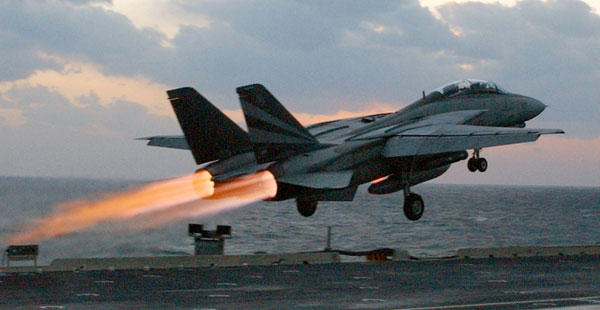
Grumman F-14 US Navy Tomcat
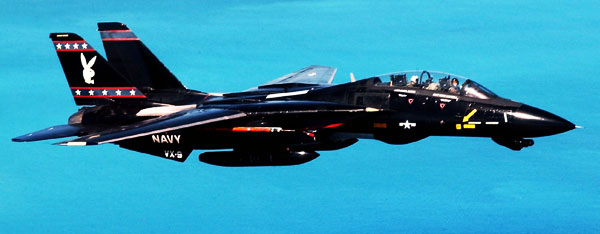
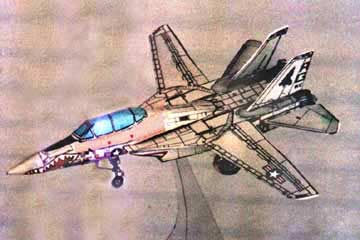
With its high speed and ultra long-range weapons, the F-14 Tomcat is the main defender of the US fleet and can operate hundreds of miles away from the carrier. Its AWG-9 radar can engage six targets at once and its Phoenix missiles can kill hostile bombers 150 km away before they can launch their attacks. The Tomcat is one of the world's true 'Top Guns'.
Variable geometry wings for this carrier based US Navy multi-mission fighter. Top Speed of 2.3+MACH and ceiling over 56,000 feet.
This model is set up so you can feature the 'swing wing' effect and is an important part of our US Navy collection.
Because of the recent state of "Heightened Security" two types of photo ID may be required to buy this model..
F-14 Tomcat
In 1970 the Tomcat was by far the most advanced fighter flying with the Western powers. Today, in some respects, it still is. Yet, like so many successful aeroplanes, it owes its success to a series of chance happenings.
The Tomcat project saw life as an urgent response to the cancellation by the US Congress in 1968 of the much-vaunted F-14B, planned as the US Navy's next fighter. Grumman, the associate contractor on the F-14B, pushed forward a design for a superior carrier-based fighter that the company already had on the stocks.
Early in 1969, Grumman received the go-ahead and the prototype F-14A Tomcat first flew on 21 December 1970. Unfortunately the second flight ended in sudden and total hydraulic failure, caused by pipe fractures, and the aircraft was lost.
Testing continued with the other eleven development aircraft and these proved to be an outstanding success. ln fact, Grumman had planned that later versions with much more powerful engines, the F-14B and F-14C, would replace the original. However, rising costs kept the F-14A in production, and at the end of the first production batch threatened the whole program because Grumman said that they could not afford to continue.
The Tomcat was designed from the outset to fulfill a variety of specialist roles in addition to its primary duty of DLI (deck launched intercept). These include various forms of CAP (combat air patrol): Forcap (interceptor cover for the fleet); Barcap (barrier air defense); and Tarcap (target cover for friendly aircraft). A quite separate design role has been attack on ground targets with heavy bomb and missile loads, though this is not used by the US Navy.
Here's a little tip I used successfully
on the FG F-14 Model. I glued
thin (gray) strips along the fuselage engine nacelles under the
wings to
form a little pocket where I could slip in the tops of the main
landing
gear struts. I then had a FG model with removable landing
gear.....
Many Thanks to Joe Cangero
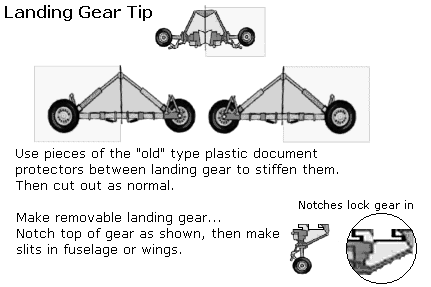
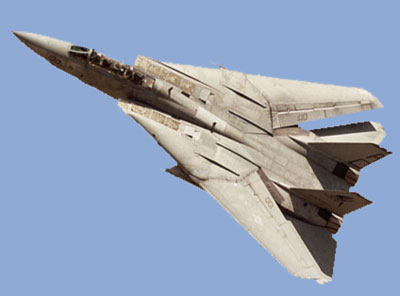 The Tomcat owes its mission versatility to
its basic configuration using variable-sweep wings and two crew,
together with incredibly powerful and versatile on-board avionics.
The wing sweep is constantly adjusted to suit both speed and maneuvers
by the use of a computer-based Mach sweep programmer. ln addition,
small foreplanes or glove vanes can be extended to give extra
control at very high speeds.
The Tomcat owes its mission versatility to
its basic configuration using variable-sweep wings and two crew,
together with incredibly powerful and versatile on-board avionics.
The wing sweep is constantly adjusted to suit both speed and maneuvers
by the use of a computer-based Mach sweep programmer. ln addition,
small foreplanes or glove vanes can be extended to give extra
control at very high speeds.
The Tomcat was designed to fight with a gross weight, including missiles, of no more than 50,000Ib. lt is a tribute to its performance that it carries out its various roles with an extra weight penalty up to 25,000lb despite the fact that its internal fuel load has been slightly reduced.
The impressive AWG-9 radar fire-control system and AIM-54 Phoenix missiles were designed as a unit by Hughes eight years before the Tomcat itself. That said, they are still proving superior as a weapon system in the mid-eighties. Even today no other fighter can pick out so many targets at so great a distance and shoot them down.
One of the problems of flying the Tomcat in peacetime, where real combat situations are very few and far between, is that it is very difficult to make full use of the weapon system's outstanding range. In a limited war situation, as so often prevails today, it is important to Jet potentially hostile aircraft come well within visual range, in order to make absolutely certain of their hostile intentions. This, of course, throws away much of the Tomcat's ability to kill at extreme range.
Recent variants have now been fitted with the Northrop TCS (TV camera set) under the nose. This seeks, locks onto and actually shows the target to both pilot and crewman at extreme ranges, long before a visual sighting could be contemplated in your quarry is one thing. Destroying it is another. And the Tomcat's armament is awesome by any standards, with one 20mm multi-barrel cannon and up to eight missiles.
In fact, the Tomcat is the only
aircraft in service that can deliver the AIM-54 Phoenix missile
which has a formidable range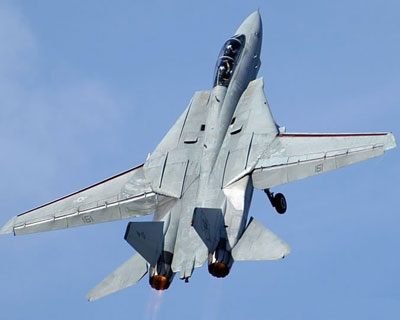 of over 125 miles. Six of these large
air-to-air missiles can be carried, along with two AIM-9 Sidewinders
for close-range use. lt is largely the heavy missile and fuel
load that makes the Tomcat one of the biggest modern fighters.
of over 125 miles. Six of these large
air-to-air missiles can be carried, along with two AIM-9 Sidewinders
for close-range use. lt is largely the heavy missile and fuel
load that makes the Tomcat one of the biggest modern fighters.
This configuration is often varied by including AIM-7 Sparrows or extra Sidewinders at the expense of the very costly Phoenix missiles, ln addition, extra fuel can be carried without reducing the missile complement in under-engine drop tanks, each of 222 gallons capacity. The internal fuel capacity is so large that these are seldom seen.
To date, over 500 F-14A Tomcats have been built, almost all for the US Navy. These have seen various engine improvements, because the initial Pratt & Whitney TF30s of 20,9001b thrust have caused extremely severe problems throughout the service life of the aircraft. Today the TF30-4 14A is doing much better, but the Navy has switched future production to the General Electric F 110.
Only one other country, apart from the United States, has taken delivery of the Tomcat. Grumman sold 80 simplified F-14As to Iran just before the Islamic revolution in that country. Lack of operating resources has kept them from a major combat role in the Gulf war with Iraq, although one squadron has kept operational throughout, in some cases being used as airborne radar controllers for other fighters.

The Tomcat, developed in place of the cancelled F-14B for the USN, was declared winner over four other competitors in a Navy design program in January 1969 and is a 2-seat, multi-purpose carrier-based fighter. The first of 12 development aircraft flow on 21 December 1970, but crashed on the landing approach after its second test flight nine days later. A second F-14 flew on 24 May 1971. The T2SN has planned procurement of 821 F-14As: about 400 were in service by 1981. Pro-revolutionary Iran received 80.
Avionics and other features are based on those already developed by Grumman for the F-14B. and landing gear on that of the A- Intruder. The F-14A has a fixed armament of one Mel-Al Vulcan 20mm multi-barrel cannon, with 675 rounds, in the port side of the lower front fuselage. There are recessed stations under the fuselage, and pylon, beneath the fixed portion of the wings, on which can be carried sm Phoenix and two Sidewinder, or four Sparrow and tour Sidewinder. air-to-air missiles; or drop tanks. The F-14As computer controlled radar and weapon systems can engage up to six aircraft at one time, and can detect targets at 115 miles. although, ironically, moot sightings are visual. The Tomcat can also be operated in the attack role, can-ying bombs or bomb-and-missile combinations up to a maximum external load of 14,500lb .
The F-14A is unique among variable-geometry ('swing-wing') aircraft in having, in addition to variable-sweep wings, small movable fore plane surfaces housed inside the leading-edge roots of the fixed portions of the wings. Fulfilling a similar function to the moustaches, of the Dassault Milan, these can be extended forward into the airstream as the main wings swing backward, controlling changed in the center-of-pressure position. The wings themselves have 20 degrees of sweep when fully forward and 68 degrees when fully back.
The first operational USN Tomcat unit was VF-1; with VF-2, this squadron flew the first operational F-14A sorties, from the USS Enterprise. in March 1974. A carrier wing normally comprises two F-14 squadrons. By 1980 16 USN squadrons operated the F-14; when not at sea they are shore-based at NAS Miramar, California, and NAB Norfolk, Virginia. Engine problems in service required modifications to the TF30 turbofan.
|
I'm building my 30th FG plane and have come across a problem with the Tomcat. I don't have any of the recommended nose weights (as shown on the assembly instructions) and was hoping somebody could help me out and maybe send me a dozen or so for the squadron I was hoping to build. ; ) When all else fails read the instructions..Mike Esperance, Australia |
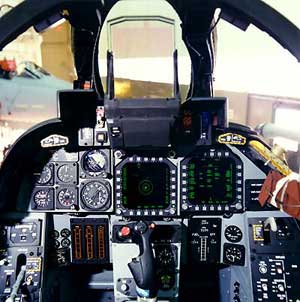 |
F-14 Tomcat Cockpit. |
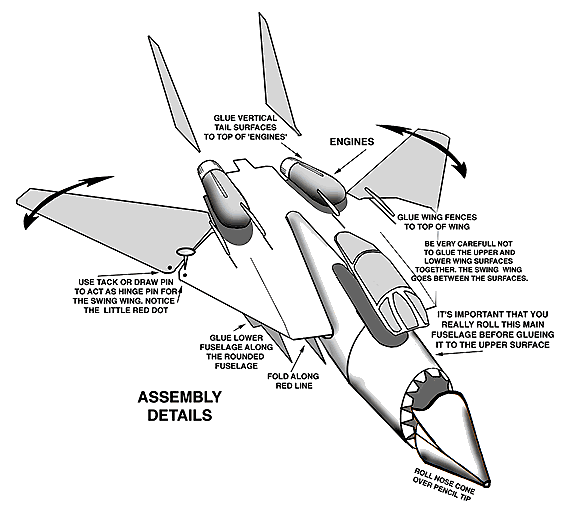
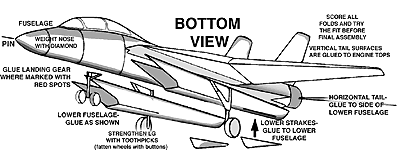
Specifications for the Grumman F-14 Tomcat
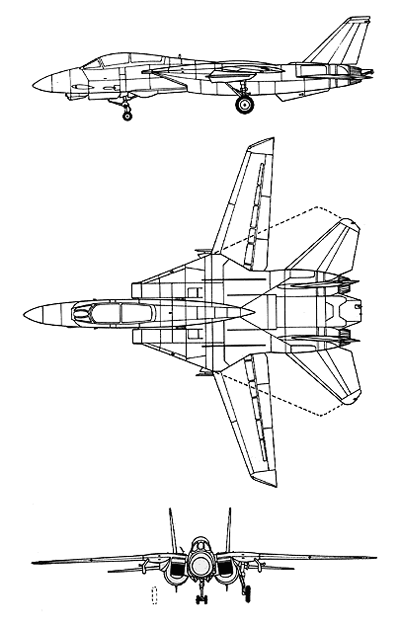 |
Span: fully swept: 38ft Armament |
 |
||
| A: The Tomcat carries a crew of two-pilot up front and Naval Flight Officer behind, controlling the radar and weapons systems. | B: The key to the F-14's success lies in its powerful Hughes AN/AWG-9 radar, which can detect fighter- sized targets at very long range, and even allows the F-14 to shoot down cruise missiles. | C: The 90-mile-ranged AIM-54 Phoenix missile steers itself toward the target using an onboard inertial navigation system, then homes in using its own onboard radar. |
| D: The Tomcat can extend its range or endurance by using in-flight refueling or by carrying external fuel tanks. | E: The F-14's powerful TF-30 turbofans give the aircraft superb performance and economy, but have proved troublesome and unreliable. | F: Highly colorful squadron markings have given way to a subdued low-visibility gray camouflage on all U.S. Navy aircraft. |
Tutorial video for the Grumman F-14 Tomcat



